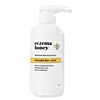What's inside
What's inside
 Key Ingredients
Key Ingredients

No key ingredients
 Benefits
Benefits

 Concerns
Concerns

 Ingredients Side-by-side
Ingredients Side-by-side

Acrylates Copolymer
Aloe Barbadensis Leaf Juice
Skin ConditioningAnthemis Nobilis Flower Extract
MaskingAvena Sativa Kernel Flour
AbrasiveCalendula Officinalis Flower Extract
MaskingCitric Acid
BufferingCocamidopropyl Betaine
CleansingCocos Nucifera Oil
MaskingDecyl Glucoside
CleansingEthylhexylglycerin
Skin ConditioningGlycerin
HumectantGuar Hydroxypropyltrimonium Chloride
Skin ConditioningHoney
HumectantLavandula Angustifolia Oil
MaskingLinalool
PerfumingPhenoxyethanol
PreservativeSimmondsia Chinensis Seed Oil
EmollientSodium Benzoate
MaskingSodium Chloride
MaskingSodium Hydroxide
BufferingSodium Lauroyl Methyl Isethionate
CleansingTrisodium Ethylenediamine Disuccinate
Water
Skin ConditioningAcrylates Copolymer, Aloe Barbadensis Leaf Juice, Anthemis Nobilis Flower Extract, Avena Sativa Kernel Flour, Calendula Officinalis Flower Extract, Citric Acid, Cocamidopropyl Betaine, Cocos Nucifera Oil, Decyl Glucoside, Ethylhexylglycerin, Glycerin, Guar Hydroxypropyltrimonium Chloride, Honey, Lavandula Angustifolia Oil, Linalool, Phenoxyethanol, Simmondsia Chinensis Seed Oil, Sodium Benzoate, Sodium Chloride, Sodium Hydroxide, Sodium Lauroyl Methyl Isethionate, Trisodium Ethylenediamine Disuccinate, Water
Ingredients Explained
These ingredients are found in both products.
Ingredients higher up in an ingredient list are typically present in a larger amount.
Cocos Nucifera Oil is obtained from the kernels of the coconut fruit. In other words, this is coconut oil.
Coconut Oil is rich in fatty acids with lauric acid making up the majority of these. It also contains linoleic acid. Due to this high fatty acid content, coconut oil helps trap moisture and soften skin.
Despite being antibacterial, coconut oil may not be great for acne-prone skin. It is comedogenic and may clog pores. This ingredient may not be safe for malassezia or fungal acne.
Note: Coconut Oil should not replace your sunscreen for UV protection. Studies show it only blocks about 20% of UV.
This oil is non-volatile and has a light scent.
The term 'fragrance' is not regulated in many countries. In many cases, it is up to the brand to define this term. For instance, many brands choose to label themselves as "fragrance-free" because they are not using synthetic fragrances. However, their products may still contain ingredients such as essential oils that are considered a fragrance.
Learn more about Cocos Nucifera OilHoney comes from bees. It is mainly made up of the sugars fructose and glucose.
Besides sugar, honey also contains amino acids, peptides, Vitamins A, C, and E. Vitamins A, C, and E.
As a humectant, honey is great at hydrating the skin. Humectants draw moisture from the air and hold it to your skin.
Honey also has antioxidant and antioxidant properties. Fun fact: darker honey has more antioxidants than light honey.
The antibacterial property of honey may make it effective at helping to treat acne. We recommend speaking with a professional if you have concerns.
Many people wonder if honey is vegan. It is technically a byproduct from bees. This is because honey is created from the digestive enzymes in a bee's stomach.
Remember to be kind to bees :) They are important for many ecosystems and are endangered.
Learn more about HoneyLavandula Angustifolia Oil is more commonly known as lavender essential oil. It is considered a fragrancing ingredient.
Lavender imparts a famous scent. While the smell is lovely, this ingredient and may sensitize skin in topical products. This is because about 85% of the oil is made up of linalool and linalyl acetate.
When exposed to air, these two compounds become strong allergens. This ingredient exhibits cytotoxicity at low concentrations; amounts of 0.25% have been shown to damage skin cells.
A study from Japan found this ingredient caused lavender sensitivity after widespread exposure.
Lavender essential oil has some antimicrobial, antibacterial, and anti-inflammatory properties. However, the cons of this ingredient may outweight the pros.
More research is needed to confirm lavender essential oil's effects when used in aromatherapy.
Lavandula Angustifolia is known as the English Lavender and famous for creating purple fields in Provence, France.
Learn more about Lavandula Angustifolia OilSodium Hydroxide is also known as lye or caustic soda. It is used to adjust the pH of products; many ingredients require a specific pH to be effective.
In small amounts, sodium hydroxide is considered safe to use. However, large amounts may cause chemical burns due to its high alkaline.
Your skin has a natural pH and acid mantle. This acid mantle helps prevent harmful bacteria from breaking through. The acid mantle also helps keep your skin hydrated.
"Alkaline" refers to a high pH level. A low pH level would be considered acidic.
Learn more about Sodium HydroxideWater. It's the most common cosmetic ingredient of all. You'll usually see it at the top of ingredient lists, meaning that it makes up the largest part of the product.
So why is it so popular? Water most often acts as a solvent - this means that it helps dissolve other ingredients into the formulation.
You'll also recognize water as that liquid we all need to stay alive. If you see this, drink a glass of water. Stay hydrated!
Learn more about Water